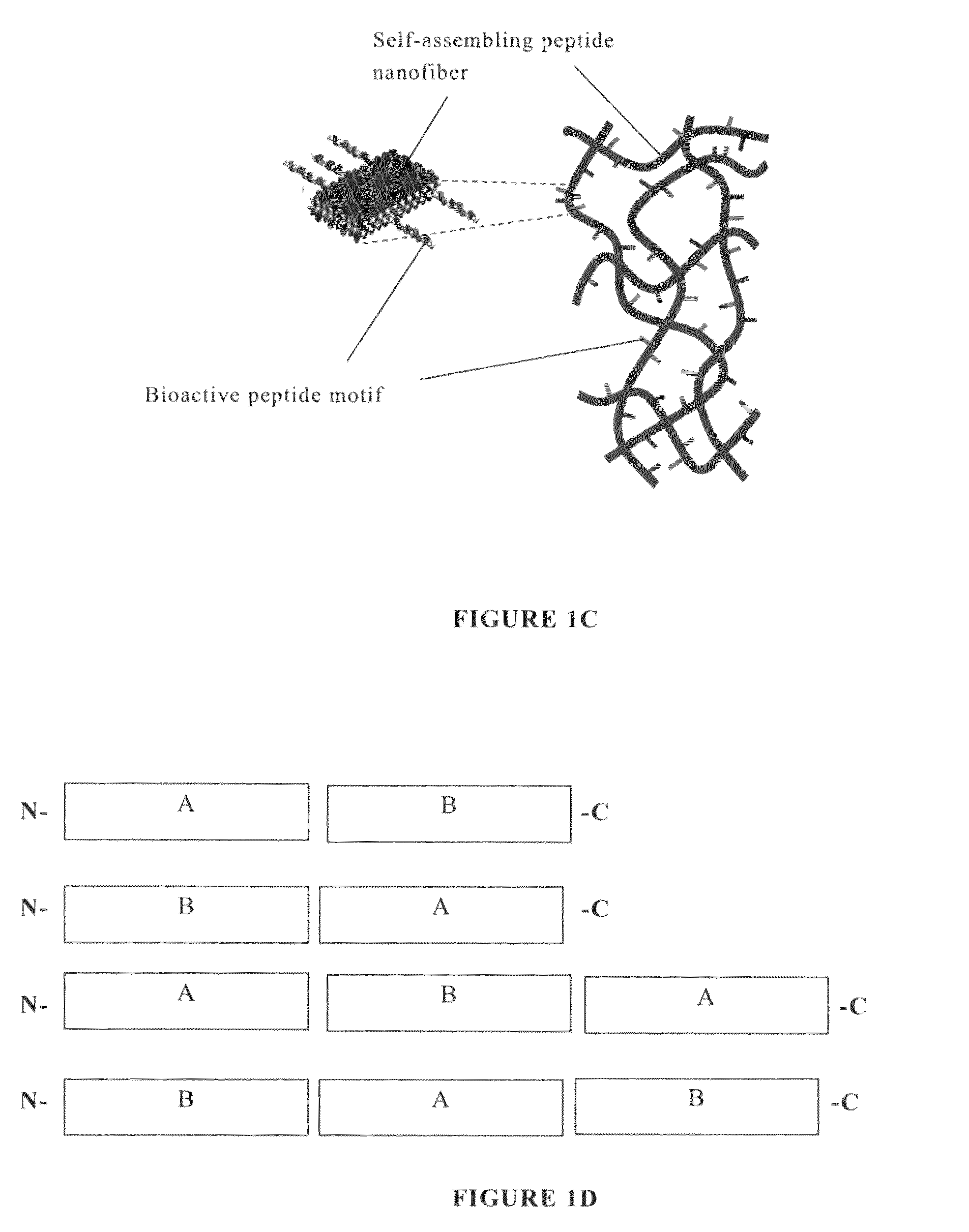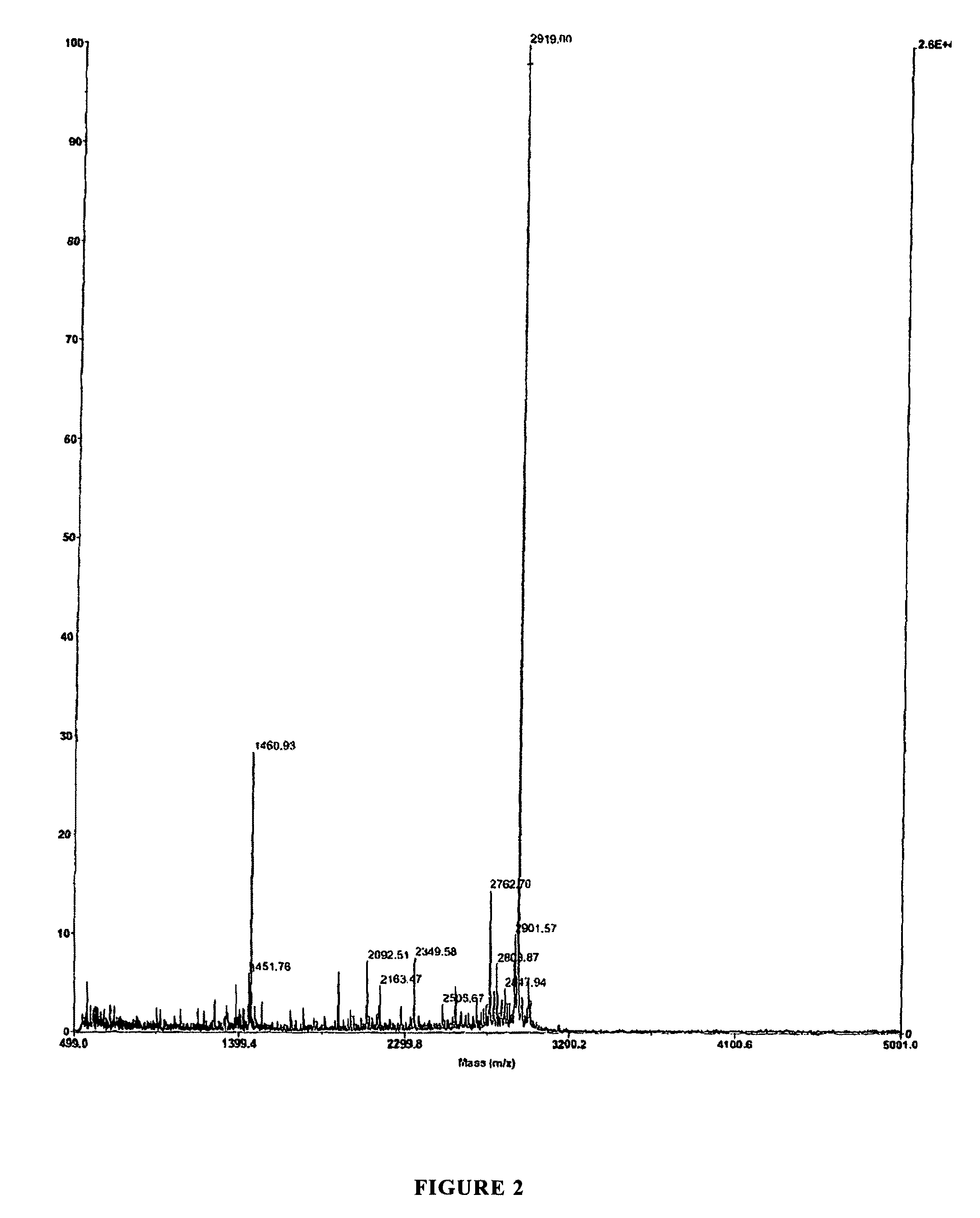Modified self-assembling peptides
a technology of peptides and peptides, which is applied in the direction of peptide sources, prostheses, drug compositions, etc., can solve the problems of difficult to ensure that different preparations of materials have a consistent, reproducible composition, and increased risk of disease transmission, so as to prevent or lessen the likelihood of disease development, reduce the severity of disease, and reduce the risk of diseas
- Summary
- Abstract
- Description
- Claims
- Application Information
AI Technical Summary
Benefits of technology
Problems solved by technology
Method used
Image
Examples
example 1
Pre-osteoblast Proliferation and Differentiation Effects
[0399]Recently, due to the aging society, problems associated with bone degeneration and bone fracture has become a significant problem both for quality of life of the patient and the social medical cost. Bone fracture in an older person is a prevalent problem due to osteoporosis but also due to poor bone regeneration. Thus, the acceleration of bone regeneration by implanting biomaterials and / or a tissue engineering approach are of interest. Also of interest is the enhancement of osteoblast activity mineralization and pre-osteoblast or stem cell proliferation differentiation.
[0400]Bone regeneration was tested using functional motifs as provided in Table 2 (Synpep Corporation). Mouse preosteoblast cell line (MC3T3-E1) was used to compare the proliferation and differentiation effects of the motifs with RAD16-1 and Collagen-I hydrogels as controls. The proliferation was measured by DNA contents and the differentiation effects were...
example 2
Effect of the Mixed Ratio of Functionalized Peptide
[0418]Effect of a mixture of self-assembling sequence peptide (e.g., 1% RAD16-1 peptide solution) and a functionalized peptide (SEQ ID NO. 7) with self-assembling sequence (RADA) (SEQ ID NO. 67) and functional motif (RGD), was evaluated (Tables 8-9) SEQ ID NO. 7 has an additional Glycine at the N-terminus (compared to SEQ ID NO. 4), which causes an increase in hydrophobicity of the hydrogel. Biologically SEQ ID NO. 4 and SEQ ID NO. 7 are considered to have similar effects.
[0419]
TABLE 8No.SequenceDescriptionSEQ ID NO. 7Ac(RADA)4Repetitive RGDGPRGDSGYRGDSGCONH2binding sequence
[0420]
TABLE 9Hydrogel contentsCodeHydrogel contentsRAD1% RAD16-1 peptide solutionDSG1% SEQ ID NO. 7 peptide solution
[0421]Hydrogels were prepared so that the mixture ratio of RAD and DSG was varied from 100:0 to 0:100 (FIG. 8). Cells were prepared and seeded as described in Example 1. Cells were cultured on hydrogels for 7 days. Cell proliferation was evaluated u...
example 3
Three Dimensional Culturing Using the Charged Functionalized Motif
[0424]Self assembling peptides hydrogels described above and herein provides cells with a synthetic extra cellular matrix (ECM) environment for 3-dimensional growth similar to that of collagen. When seeding the cells 3 dimensionally, the self assembling peptide solution should be stored at low pH (usually a pH of between 2-3) to keep viscous solution state. However, mixing living cells into low pH solution for long time significantly impacts cell viability (e.g., it is known that a few minutes in pH 2-3 solution, most human cell viability is significantly lost). Thus, when seeding the cells with a solution of the self assembling peptide at low pH, (1) the cells are added, and (2) the pH is immediately brought to near-neutral (pH between 5-8) or basic.
[0425]FIG. 10 shows the isoelectric plot and corresponding rheological rheological data when 0.1 N NaOH solution is added to RAD16-1 1% solution. At the point of pH 3.6, ...
PUM
| Property | Measurement | Unit |
|---|---|---|
| pore diameter | aaaaa | aaaaa |
| size | aaaaa | aaaaa |
| size | aaaaa | aaaaa |
Abstract
Description
Claims
Application Information
 Login to View More
Login to View More - R&D
- Intellectual Property
- Life Sciences
- Materials
- Tech Scout
- Unparalleled Data Quality
- Higher Quality Content
- 60% Fewer Hallucinations
Browse by: Latest US Patents, China's latest patents, Technical Efficacy Thesaurus, Application Domain, Technology Topic, Popular Technical Reports.
© 2025 PatSnap. All rights reserved.Legal|Privacy policy|Modern Slavery Act Transparency Statement|Sitemap|About US| Contact US: help@patsnap.com



